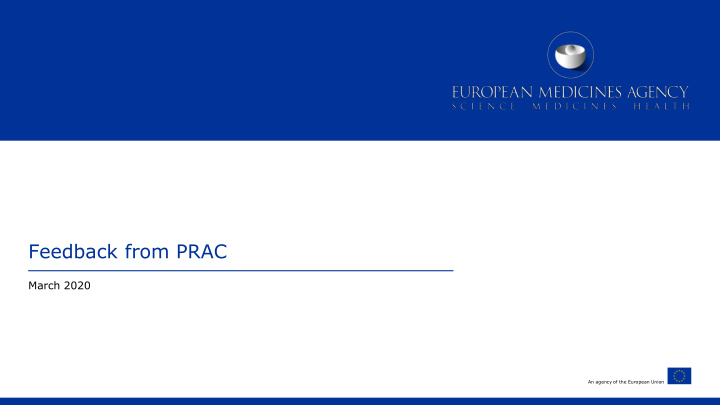



Feedback from PRAC March 2020 An agency of the European Union
Pharmacovigilance Risk Assessment Committee Representatives from each member states + 6 independent experts + Members representing healthcare Members representing patients' professionals organisations Raymond Anderson Cathalijne van Doorne Pharmaceutical Group of the European European Federation of Neurogical Union (PGEU) Associations (EFNA) Alternate Alternate Roberto Frontini Virginie Hivert European Association of Hospital EURORDIS - Rare Diseases Europe Pharmacists 1 Presentation title (to edit, click Insert > Header & Footer) Classified as public by the European Medicines Agency
PRAC Workplan 2020 & involvement of civil society representatives 1.1.2. Life-cycle approach to pharmacovigilance and 1.5.3. Measuring the impact of pharmacovigilance risk management (Cathalijne & Raymond) activities (Cathalijne) By ensuring robust, feasible and risk proportionate planning of Systematically measuring patient-relevant health outcomes of major pharmacovigilance activities including risk minimisation and regulatory interventions (e.g. post referral procedures) and key further collection of data and information, the work of the PRAC pharmacovigilance processes enables the focus of pharmacovigilance supports the protection and promotion of public health . The work to fall on those activities and regulatory tools that make a difference of PRAC also underpins innovation throughout the product lifecycle in daily healthcare . → Improve pharmacovigilance through feedback thereby and supporting the delivery of new treatments to patients, on impact of regulatory actions fulfilling unmet medical needs . 2.3.1. Engage patients and healthcare professionals, 1.3.1. Information from real-world clinical use of communication with stakeholders (PRAC topic leader: medicines (Virginie & Roberto) Raymond + Cathalijne, Virginie and Roberto as participants) Collection and analysis of data from the real-world use of The engagement of patients and healthcare professionals is important medicines is important in supporting assessment and decision- for effective pharmacovigilance. Patients and healthcare professionals making on how medicines are used, their effectiveness and their can be involved throughout the process from risk management safety. Use of epidemiological approaches is key and enablers planning , through reporting of suspected adverse drug reactions , include access to electronic health and insurance records , clear assessments and decision e.g. through PSURs and referrals and on governance, and collaboration across stakeholders including academia. benefit-risk communications. For PRAC, key engagement has included Data and information from the real-world use of medicines is a key membership of the committee , patients’ and healthcare professionals’ enabler for access to new treatments and will support the PRIME reporting , involvement in ad-hoc expert groups and scientific scheme and Adaptive Pathway initiatives. advisory groups , public hearings and targeted written 2 consultations . Classified as public by the European Medicines Agency
PRAC Statistics September '19 to February '20 77 Number of Safety Signals assessed Number of Periodic Safety Update Reports (PSUR’s) reviewed 424 Number of Risk Management Plans for centrally authorized products reviewed 328 Number of Post-Authorisation safety studies reviewed 151 Number of Referrals reviewed 8 New Communication on EMA Website Direct Healthcare Professional communication will be regularly published on the EMA website from February 2020. DPHC’s inform HCP’s about new safety information on a medicine and will be published on the EMA website at the time of national dissemination. The new webpage will also include links to national registers of DHPC’s. 3 Classified as public by the European Medicines Agency
Key Recommendations from the PRAC Estradiol Creams (High-strength): Recommendation limiting use to a single treatment period of up to four weeks to minimize risk of side effects e.g. blood clots & strokes Lemtrada (Used in M/S): Recommendation to restrict use due to rare but serious side effects (including death) from immune-mediated conditions and serious disorders of the heart, circulation and bleeding. Xeljanz (Used in active RA): Recommendation to be used with caution in patients at high risk of blood clots. Picato (Used in actinic keratosis) Recommendation patients stop using Picato while review into possible link with skin caner is ongoing Cyproterone : Recommendation medication containing 10mg or more should only be used in certain conditions once other treatments have failed (or not suitable) and not used in people who have or have had a meningioma 4 Classified as public by the European Medicines Agency
Recommend
More recommend